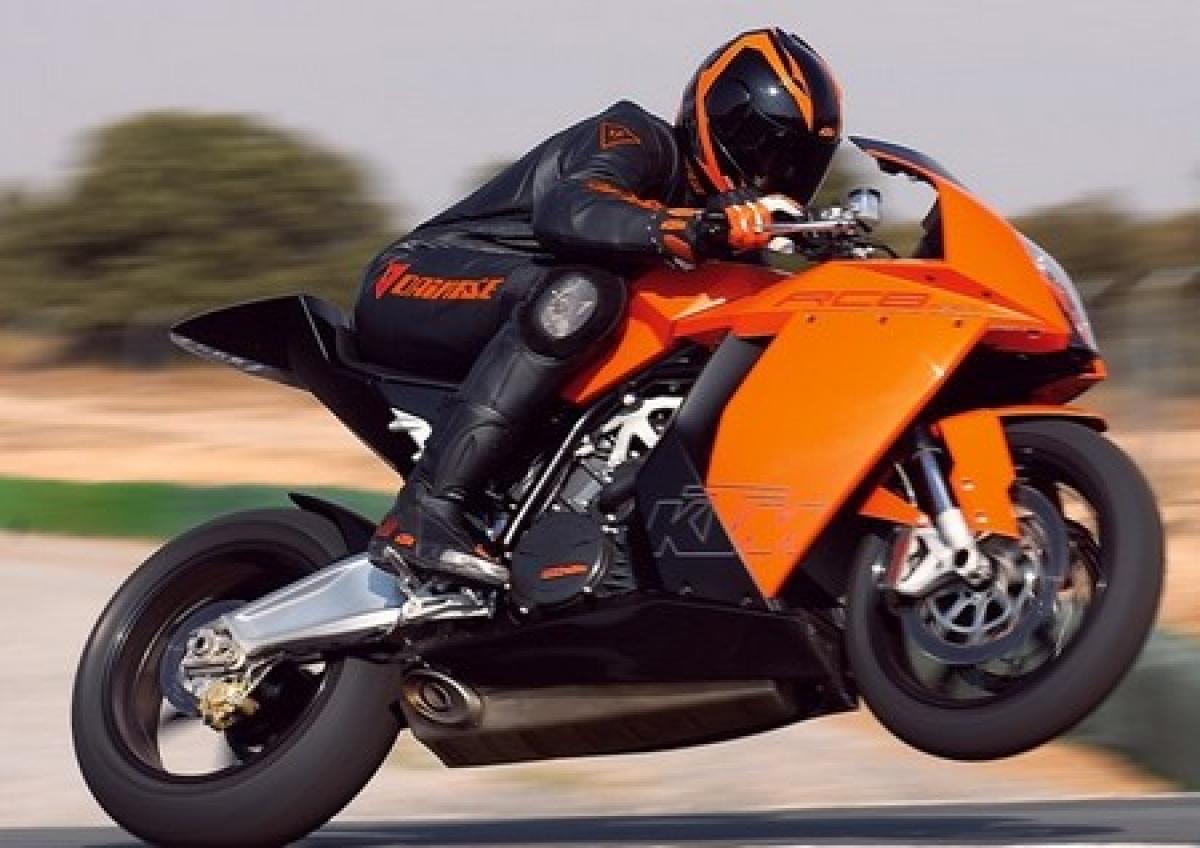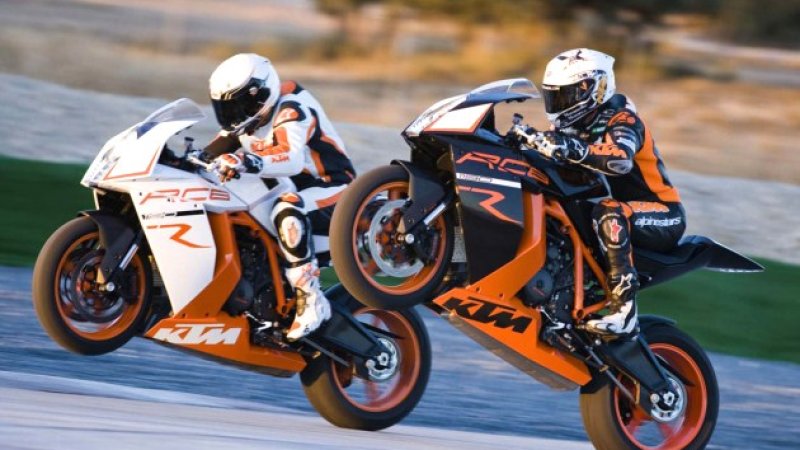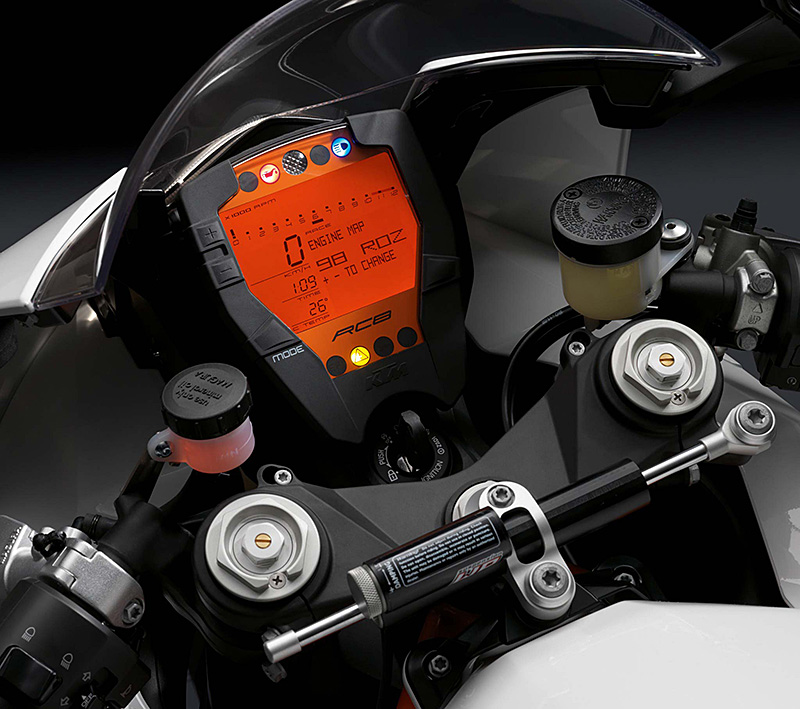Motorcycle Investor mag
Subscribe to our free email news

KTM RC8 & RC8R – future collectible
by Guy ‘Guido’ Allen
October 2020

Peak Orange
KTM’s two-model run from 2008 with the RC8 was courageous
Saying the phrase ‘KTM sports bike’ 15-20 years ago was a little like saying ‘fish on a bicycle’. Now, not so much. For the vast majority of its production history, the KTM name has not been associated with litre class sports bikes.
For most of us, the thought that KTM might even consider getting into big sports bikes didn’t pop over the horizon until 2003, when it launched the admirable Adventure 950. It was regarded by many as the first bike to really take the fight up to BMW’s mighty GS twins – very high praise at the time.
Regardless of whether adventure touring is your bag, the real highlight was the 75-degree V-twin powerplant, itself called the RC8. There was nothing particularly revolutionary about it pretty much the whole way through the development cycle – essentially a liquid-cooled twin with four valves per pot and fuel injection.
I can recall punting the first Adventure through some backroads on the way to Omeo, wondering what the cackling V-twin would be like in a road chassis. Pretty damned good was the only result you could come to.
Sure enough, KTM eventually came to the same conclusion, rolling a 990 version of the powerplant into the naked Super Duke by 2005.
The bike that really got everyone’s attention though was the one that ended up carrying the project name of its powerplant, the RC8. That KTM – best known for its sharp dirt bikes - was brave or foolhardy enough to step into the proverbial lion’s den of big sports bike was a big story on its own. That it did so with something that looked like a cross between a stealth bomber and a motorcycle pretty much guaranteed headlines.

The controversial lines were penned by Gerald Kiska
(above), who played a role in establishing the look of the
firm’s dirt bikes and the Adventure series.
In a piece written for Visor Down
online, when the RC8 was still in the market, he
said:
“The RC8 was inspired by KTM’s off-road bikes. I tried to bring the design language that I developed for their off-road bikes to the street market. The approach was a simple one, we tried to take the elements we used in the off-road bikes and transfer them to the on-road ones. The RC8 was what came out. If you look at the tank spoilers that you have on a motocross bike they are a plain surface, with no openings on them, this idea was then developed for the side fairing on the superbike.
“Comparing the original 2003 Tokyo concept bike with the final version it seems very close, but it is not. Between 2003 and 2008 the design and fashion in supersports bikes changed quite a lot. The rider’s position has moved extremely far forward so that the distance between the handlebar and the seat is much shorter. The whole weight distribution of the superbike has moved further forward. We took elements and the design idea of the concept but changed the proportions quite a lot because of this and other problems we encountered.
“There have been some issues with showing the prototype so long ago. A few other companies have seen that KTM’s design is successful in the market and people appreciate it. As soon as they realise this they have started to pick this and that and transferred it into their own designs and models. One of the methods we came up with in 2003 was the under-slung exhaust, this was never seen before on a superbike at that time. Now, if you look, all companies are trying to develop similar solutions to our approach.”
After poaching project leader Claus Holweg from Rotax, KTM took near enough to a decade to see the big twin finally shoe-horned into its namesake sports bike.
In 2008, KTM was going up against the might of Ducati’s 1098 series and was fighting for headline space with Buell’s 1125R – that was pretty much the state of the sports V-twin market.

The result? Pretty damned good.
What about maintenance and reliability? Caring and feeding present no special problems. There seemed to be a few teething troubles with the transition of the fuel injection from idle and across low speeds, something that was tackled on the run and addressed a little more thoroughly with the R version (above). Also, some gearboxes could be notchy, but the complaints were on new machines and more than likely cleared up as they were fully run in. The factory also did a parts update on the selector as part of the early service process.
All up, however, we’re just not hearing much in the way of complaints about reliability on these things. The reputation of the brand’s dirt machines has occasionally been fragile at times over the years, but the big road twins seem to have had relatively clear sailing. Mileages tend not to be huge and we suspect owners have so far showered them in attention, which helps.
As a ride, they are truly impressive: fast, easy to ride quickly and with tremendous feedback. The engine is a peach when wound up, with slightly better sorted injection on the R model and a little extra poke towards the red end of the tacho. I wouldn’t describe either engine as peaky, though the R model has a little more racer snarl about it. That means it can punch out of corners very effectively from medium revs.
The chassis on both variants feels quick-turning and sharp, without any sense of instability. We’re talking about a machine that can make an average rider look pretty good.
Braking was state of the road bike art for the time and stands up well today, while the suspension is exceptionally well-sorted on both models. Yes, the R is a level up on its slightly cheaper predecessor, but I would not feel cheated with the ‘standard’ bike.

Something which makes a huge difference to how the machine feels is the class-leading adjustability built into it. You can alter seat height, handlebar and controls positioning, all by meaningful amounts and it comes as a bit of a revelation that you can set it up to be comfortable, despite the sporting pretensions.
KTM really struggled to get volume on these things and I suspect the premium pricing played a significant role in that. Sure it’s a high-end product, but it also had a lot to prove and that controversial styling probably has a niche audience.
The company did tip its corporate toe in the water with racing, including a one-make series supporting the Brit superbikes, and it generally did pretty well. However there wasn’t enough thrown at it to seriously rival the hard-won efforts of the likes of Aprilia and Ducati.
KTM seems to have had an ambivalent attitude to full-house sportsbikes over the years, with company director Stefan Pierer in 2015 arguing against developing hyperbikes for the road. He said, “But let’s be honest, if your Superbike is reaching 200 horsepower or more, it’s impossible to argue that it belongs on the street. It really doesn’t, anymore.”
Which makes the inauguration of a two-bike MotoGP team for 2017 an interesting development. The company has so far said it will build customer track-only versions, but no road bike offshoots.
So, could the RC8 and RC8R be the first and last of KTM’s
litre class sports bikes? I suspect it’s too early to
tell. (We've since seen the launch of the track-only RC
8C, but no big road replacement.)
However, if your motorcycling tastes run to something that’s a little different to the usual inline fours, the RC8s should be more than enough to keep you entertained. Plus, over the long term, they will continue to mark a significant point in the company’s history and should over time develop some real collector interest. In the meantime, think of all the fun you could have on one!

For
Fast
Sharp
Distinctive styling
Against
Quirky styling
Short model run
SPECS:
KTM RC8/RC8R
ENGINE:
TYPE: Liquid-cooled, four-valves-per-cylinder, 75-degree
V-twin
(twin-plug heads in R model)
CAPACITY: 1148/1175cc
BORE & STROKE: 103 x 69/105 x 69mm
COMPRESSION RATIO: 12.5:1/13.5:1
FUEL SYSTEM: Fuel injection
TRANSMISSION:
TYPE: Six-speed, constant-mesh (slipper clutch on RC8R)
FINAL DRIVE: Chain
CHASSIS & RUNNING GEAR:
FRAME TYPE: Steel lattice
FRONT SUSPENSION: WP 43mm USD full adjustment
REAR SUSPENSION: WP monoshock full adjustment
FRONT BRAKE: 320mm disc with radial mount 4-piston Brembo
calipers
REAR BRAKE: 220mm disc with two-piston Brembo caliper
DIMENSIONS & CAPACITIES:
DRY WEIGHT: 188kg
SEAT HEIGHT: 805-825mm
WHEELBASE: 1430/1425mm
FUEL CAPACITY: 16.5L
WHEELS & TYRES:
FRONT: 3.50 x 17, 120/70 ZR17 (cast/forged)
REAR: 6.0 x 17, 190/55 ZR17 (cast/forged)
PERFORMANCE:
POWER: 114/127kW
TORQUE: 121/123Nm
OTHER STUFF:
PRICE NEW: Au$27,000/32,000 (+ORC)
More KTM: 950 Super Enduro
-------------------------------------------------
Produced by AllMoto abn 61 400 694 722
Privacy: we do not collect cookies or any other data.

Archives
Contact




